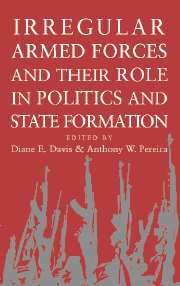Book contents
- Frontmatter
- Contents
- Contributors
- Irregular Armed Forces and Their Role in Politics and State Formation
- Introduction
- 1 Contemporary Challenges and Historical Reflections on the Study of Militaries, States, and Politics
- Part I The Basic Framework and Beyond
- Part II Deconstructing Armed Forces
- Part III Not Just the Nation-State
- Conclusion
- Index
1 - Contemporary Challenges and Historical Reflections on the Study of Militaries, States, and Politics
Published online by Cambridge University Press: 23 November 2009
- Frontmatter
- Contents
- Contributors
- Irregular Armed Forces and Their Role in Politics and State Formation
- Introduction
- 1 Contemporary Challenges and Historical Reflections on the Study of Militaries, States, and Politics
- Part I The Basic Framework and Beyond
- Part II Deconstructing Armed Forces
- Part III Not Just the Nation-State
- Conclusion
- Index
Summary
War-Making in the New Millennium
The post—Cold War era ushered in a new wave of optimism about an end to world wars and a possible reduction in global-scale violence. As the new millennium loomed large, heightened expectations about world peace and global political stability captured the imagination of those who scarcely a decade earlier concerned themselves primarily with war-making among superpowers and their satellites. Shifting rhetorics and rising expectations were further fueled by the so-called third wave of democracy that continued materializing in the post-1989 world. As democratization and globalization reached ever further corners of the globe, long-standing claims of political scientists that democracies do not fight each other took on greater significance. For many security analysts, new forms of regional and international economic cooperation between countries committed to a common project of liberalization also promised to reduce the likelihood of widespread global conflict.
But now, from the vantage point of a new millennium, and in a post-9/11 world, initial optimism seems muted. Few would counsel that the threat of armed conflict is on the wane, at least insofar as violence and armed coercion still continue as facts of life. Even as a tentative peace settles in among previously contending geopolitical superpowers struggling over spheres of influence, those countries and regions that lay in the interstices of this larger power structure — and whose fates not that long ago seemed overdetermined by the economic or political competition between Cold War antagonists — are beginning to implode with greater frequency.
- Type
- Chapter
- Information
- Publisher: Cambridge University PressPrint publication year: 2003
- 9
- Cited by

